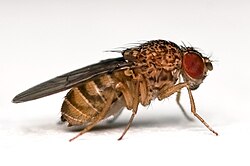| Drosophila repleta | |
|---|---|
 | |
| Scientific classification | |
| Domain: | Eukaryota |
| Kingdom: | Animalia |
| Phylum: | Arthropoda |
| Class: | Insecta |
| Order: | Diptera |
| Family: | Drosophilidae |
| Genus: | Drosophila |
| Species: | D. repleta |
| Binomial name | |
| Drosophila repleta Wollaston, 1858 | |
| Synonyms | |
| |
Drosophila repleta is a species of vinegar fly in the family Drosophilidae. [1] [2]
Contents

D. repleta is a subtropical species, and is well adapted to warm, urbanized environments. [3] D. repleta is a carrier of foodborne illness - including Escherichia coli O157:H7, Salmonella Saint Paul, and Listeria innocua - onto human food. [4]